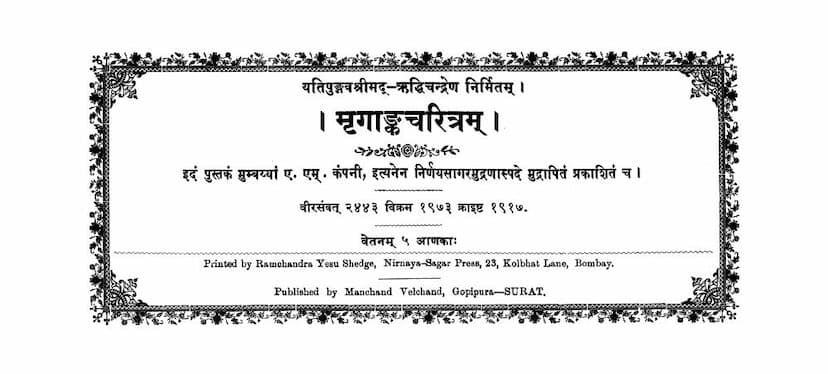Mrugank Charitram
Added to library: September 2, 2025

Summary
Here's a comprehensive summary of the Jain text "Mrugank Charitram" by Ruddhichandra Yati, based on the provided pages:
Overview:
"Mrugank Charitram" is a Jain narrative detailing the life and spiritual journey of Mrugankakumara (Prince Mrugank). The text, written in a poetic and descriptive style, follows his early life, a period of hardship and separation, his eventual reunion, and his ultimate spiritual realization and liberation. It emphasizes the importance of good conduct, wisdom, spiritual devotion, and the consequences of actions (karma).
Key Characters and Setting:
- Mrugankakumara: The protagonist, prince of Varanasi, known for his beauty, intelligence, and eventually, his strong spiritual inclination.
- Padmavati: The daughter of Dhananjaya, a wealthy merchant, and Mrugankakumara's childhood friend and eventual wife. Their mutual affection is a significant element of the story.
- Kusumsaraka: A wealthy merchant and Mrugankakumara's maternal grandfather.
- Dhananjaya: A wealthy merchant, Padmavati's father.
- King Makaradhwaj: Mrugankakumara's father, the king of Varanasi.
- King Nrabrahma: A king Mrugankakumara encounters later in his journey.
- Sahasaanka: An alter ego or transformed identity of Mrugankakumara, used during his time away from home, showcasing his adaptability and intelligence.
- Setting: The story begins in the city of Varanasi, a beautiful and prosperous city, and expands to include journeys by sea and other kingdoms.
Narrative Summary:
-
Early Life and Education: The story introduces Prince Mrugankakumara, renowned for his exceptional qualities. He receives a comprehensive education in various arts and sciences, alongside Padmavati, the daughter of a wealthy merchant. Their bond deepens through their shared learning experiences.
-
Separation and Hardship:
- Mrugankakumara is sent for further studies. During this period, a misunderstanding arises with Padmavati over a small matter (a packet of coins meant for her that Mrugankakumara consumes). This incident, though minor, leads to a period of estrangement and foreshadows future trials.
- Later, while on a sea voyage for trade, Mrugankakumara's ship is attacked by pirates or demons (Rakshasas). He is separated from his wife, Padmavati, who is left behind on a raft. This event marks a significant turning point, initiating a period of severe hardship and spiritual reflection for both.
-
Mrugankakumara's Journey as Sahasaanka:
- Left alone, Mrugankakumara, through the power of his knowledge and potentially a divine intervention (implied by the narrative), transforms into "Sahasaanka."
- As Sahasaanka, he travels to a kingdom ruled by King Nrabrahma. He demonstrates his sharp intellect by solving complex riddles presented by the king, earning him respect and the position of a teacher for the royal princes.
- During his time as Sahasaanka, he demonstrates his skill in various arts and his ability to overcome challenges, including confronting a cunning thief who terrorized the kingdom. He also obtains potent magical skills (vidya) from a Vidyadhara (celestial being).
-
Padmavati's Ordeal and Spiritual Endeavor:
- Padmavati, left adrift, is rescued by a merchant. However, the merchant harbors impure intentions.
- She finds refuge in a forest and, through her devotion to the Jinism, performs acts of worship, meditating and reciting prayers. Her unwavering faith and conduct are highlighted.
- Her suffering and resilience are portrayed, emphasizing her spiritual strength.
-
Reunion and Further Trials:
- Eventually, through a series of events and fortunate circumstances, Mrugankakumara (as Sahasaanka) and Padmavati are reunited.
- However, their reunion is complicated by Mrugankakumara's current role as a Shaukika (likely a tax collector or royal attendant responsible for accounts) and a misunderstanding that leads to Mrugankakumara being imprisoned by the king.
- Mrugankakumara, facing injustice, uses his wits and the knowledge of the magical skills he acquired. He demonstrates the futility of his captor's plans and ultimately proves his innocence.
-
Spiritual Realization and Liberation:
- After overcoming these trials, Mrugankakumara and Padmavati are recognized for their virtues.
- They encounter a spiritual teacher (Suriji), who imparts further spiritual wisdom.
- Through the teachings, they understand the transient nature of worldly possessions and the importance of spiritual practices for achieving liberation.
- The text recounts their past lives and the karmic reasons for their earthly experiences. Mrugankakumara's current life is a result of past good deeds, and Padmavati's presence is also karmically linked.
- The narrative concludes with Mrugankakumara, now king of Varanasi (having received half the kingdom and his daughter in marriage from King Makaradhwaj), dedicating himself to righteous governance and religious activities.
- He, along with Padmavati, eventually renounces the worldly life and achieves liberation (moksha) through spiritual discipline.
Key Themes and Teachings:
- Karma: The story strongly emphasizes the law of karma, illustrating how past actions influence present circumstances and future rebirths.
- Virtue and Conduct (Sheel): Characters like Padmavati are praised for their steadfast virtue, which aids them in overcoming adversity.
- Importance of Education and Wisdom: Mrugankakumara's intelligence and acquired knowledge are instrumental in his survival and eventual success.
- Devotion to Jain Principles: The narrative highlights the efficacy of prayers, worship, and adherence to Jain teachings in navigating life's challenges.
- Detachment from Worldly Affairs: The ultimate goal is depicted as renunciation of worldly attachments and pursuit of spiritual liberation.
- The Transient Nature of Life: The story underscores that worldly happiness and suffering are temporary, and true bliss lies in spiritual attainment.
Publication Information:
The book was printed and published in 1917 (Vikram Samvat 1973, Veer Samvat 2443) by the Nirnaysagar Press in Bombay. The catalog link provided is for JainQQ.org.
Overall, "Mrugank Charitram" is a Jain moral and spiritual tale that aims to inspire readers to cultivate virtues, understand the principles of karma, and strive for spiritual liberation through righteous living and devotion.